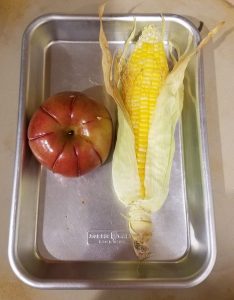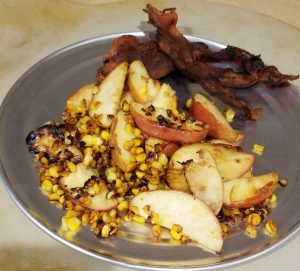Civil War Cooking: Corn and Apples with the 17th Virginia Infantry
In Private Edgar Warfield’s memoirs, he describes his experiences in the 17th Virginia Infantry Regiment on marches, in camp, and during battle. His writings about the Maryland Campaign of 1862 gives a glimpse of the deprivations the soldiers in his unit endured. He described his own appearance at this time:
I was not entirely shoeless, for I had the soles of my shoes held to the uppers by pieces of bandages, which I had to renew quite often. But I was good and ragged, all right! My hat I had found at a farmhouse in Virginia. It was part of a straw that had been painted or varnished black, and half of the rim was missing. It took the place of a good brown felt hat that I had up to within a few days or our entering on Maryland soil and that I lost one night when, tired and footsore, I was allowed by the drive of one of the wagons of our regiment to get in and ride. Crawling out just before daybreak I found that my hat was missing. It had evidently fallen out during the night….
One of Warfield’s friends—Alexander Hunter—included details in the memoirs about the food this regiment ate during the campaign, “We lived on apples and green corn all of this time, and the soldiers began to drop out of the ranks at every halt.” Clearly, the high fiber diet had its problems, probably coupled with drinking bad water on the march.
Hunter went on and gave details that the produce was carried in “cotton haversacks” and also explained how the soldiers prepared and ate the food:
“Apples and corn, corn and apples, were our only fare. We ate them raw, roasted, boiled together, and fried. They served to sustain life and that was all. I have often been asked about the ‘Rebel yell.’ I have always answered that the Rebs were savage with hunger, and men always ‘holler’ when hungry.”
Taking the history to the modern kitchen…
I did not want to attempt a green corn experiment and purposely make myself unwell, but autumn, field fresh corn I could find. Deciding it would be frowned upon to raid the field at Spotsylvania battlefield, I headed for the local Farmer’s Market. Apples were easy; I still had a bunch left over from my apple picking adventure in the Shenandoah Valley earlier in the season.
For four days, I planned to eat only corn and apple for lunches, following the “cooking tips” from the 17th Virginia. Here are my historical food journal notes:
Easy! Husk the corn. Wipe the orchard dust off the apple. Time to eat.
Today, I find out that I bought sweet corn at market. So sweet that it should be called “candy corn.” It’s delicious, but I really don’t think it’s an authentic flavor. The apple is a Rome variety…not quite sure if that is a historic type, but the orchard where I picked has been there since the early 20th Century. I’m thankful for the slight tartness of the apple to balance the over-sweetness of the corn.
Would I eat this regular? Probably not at home. But I do think it’s an option I might consider for a battlefielding day. Easy to transport in a backpack, no need to keep cool, and pretty good flavor, and quick way to intake carbs and natural sugars for quick energy.
Without access to a campfire, I have to resort to roasting in a modern oven on a baking sheet. Suggestions online recommend roasting corn at 350 degrees with a few husks still around the corn (but all the silk removed). I decide to skip the butter and herb suggestions this time since I don’t think Johnny Reb had that available.
To help the apple cook faster and more evenly, I score it on all sides. Placing both corn and apple on the same baking sheet, I slide it into the oven and head back to my work desk. Before long, the roasting food smells amazing!
After about a half-hour, it’s looking good and it’s time to eat…
Spoiler alert: this was my favorite way to prepare these foods.
The roasting brings out a really nice flavor from the corn and I think it was much easier than boiling the ear of corn (the way I would typically prepare it). As for the apple, oh my…it is basically like a baked apple, but without the extra sugar or spices. I will definitely be roasting corn and apples again.
I’ve had to think about how to do this. I suppose the soldiers might have shucked the corn and tossed it in boiling water and maybe sliced and boiled the apple? But there are other ways, and by Day 3, I want to mix things up.
I decide to slice the kernels off the cobb. I had sliced and oven-dried an apple the previous evening, thinking that might simulate an apple carried on the hot march for a little while. Tossing both corn kernels and dried apple pieces into a little boiling water starts the creation of some sort of…mush?
It works! By boiling dried apple, those pieces hold form instead of becoming applesauce. I spoon the hot mixture into a tin cup and get ready for the first bite. It’s good. But I feel like “Stonewall” and the lemonade – it’s too sweet, but I don’t think the Virginian soldiers would complain so I won’t either.
I have to make do without the smoky accent of cooking in cast iron over an open fire, but let’s see if I can get a historic flavor. I’ll start with some bacon to get some grease. While the bacon cooks, I slice the apple and the corn kernels.
Okay, ready to fry. Already I’m thinking it looks really greasy by modern standards, but it smells alright and will probably be pretty accurate to the war era. I cook it until the apples are browning and the corn just starting to burn a little, then pour it on my plate.
First bite. Yep. Super greasy. Almost gross, I think. But I can see why hungry soldiers would really like this. The flavor is good and they wouldn’t be calorie counting! A little unimpressed, I set the plate aside to take a phone call. When I come back a few minutes later, the slimy texture is gone (cooled); I find it more palatable and finish the meal, liking the flavor of the slightly burnt corn.
I like the concept of fried corn and apples, but if I make it again I’ll probably “go modern” and add a little onion, some herbs, and fry it lightly in some olive oil. It would be a good camping dinner.
Conclusion
I enjoyed cooking these lunches and experimenting with cooking the same foods in four different ways. I’ll definitely be roasting corn and apples again, and when I do, I’ll remember the 17th Virginia Infantry and be grateful for their “school of the cooking soldier” that I was able to recreate nearly 160 years later.
Source:
Warfield, Edgar. Manassas to Appomattox: The Civil War Memoirs of Pvt. Edgar Warfield, 17th Virginia Infantry. EPM Publications, McLean, Virginia. 1996. Pages 107-110





My great great grandfather was in Company E of the17th VA infantry. Great article. The Warfield diary is a great read. Wish we could get permission to publish the John Zimmerman diary which is another fabulous history of the 17th VA